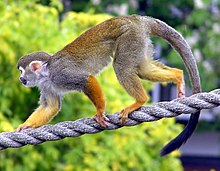Herpes virus saimiri
| Herpes virus saimiri | ||||||||||||||||||||
|---|---|---|---|---|---|---|---|---|---|---|---|---|---|---|---|---|---|---|---|---|
| Systematics | ||||||||||||||||||||
|
||||||||||||||||||||
| Taxonomic characteristics | ||||||||||||||||||||
|
||||||||||||||||||||
| Scientific name | ||||||||||||||||||||
| Saimiriine gammaherpesvirus 2 | ||||||||||||||||||||
| Short name | ||||||||||||||||||||
| SaHV-2 | ||||||||||||||||||||
| Left | ||||||||||||||||||||
|
The herpesvirus saimiri ( HVS , SaHV-2 , also squirrel monkey herpesvirus 2, herpesvirus saimiri 2 or Saimirines herpesvirus 2, scientifically Saimiriine gammaherpesvirus 2 ) is a virus from the genus Rhadinovirus that was found in 1968 during the cultivation of primary kidney cells of a squirrel monkey ( Saimirius ) was identified. SaHV-2 is the type species of the virus genus defined later. Its ability to cause malignant lymphoma in other monkeys was unusual . A cross-species experimental infection of night monkeys also resulted in a lymphoma and lymphatic leukemia
Based on this property as a tumor virus in primates , it is considered an important model virus in experimental tumor research for the investigation of oncogenic properties of other viruses such as the Epstein-Barr virus and the human herpes virus 8, which also belongs to the rhadinoviruses, as well as the basic mechanisms of lymphoma development.
virology
SaHV-2 has a large number of genes that correspond largely or completely to homologous gene products of the host cell , such as proteins of the cell cycle such as cyclin D , various apoptosis inhibitors, interleukin-17 and other cytokines , as well as proteins of the nucleotide metabolism. The two virus proteins stpC and tip in particular have transforming properties , the former fulfilling the properties of an oncogene due to its interaction with Ras . SaHV-2 is closely related to the herpes virus ateles , which was isolated from spider monkeys ( Ateles spp.).
Biological properties
The SaHV-2 has the common squirrel monkey of the South American rainforest as a natural host . The animals become infected naturally through contact with saliva in the first two years of life. In this species of New World monkey, SaHV-2 does not cause any infectious disease , nor are these animals affected by any lymphatic disease. The virus persists apathogenously in T lymphocytes for life .
In other New World monkeys such as tamarins ( Saguinus spp.), Common marmoset ( Callithrix jacchus ) and eastern gray-throated night monkeys ( Aotus trivirgatus ), T-cell lymphoma develops around two months after experimental infection with high amounts of virus ( intramuscular or intravenous ) . This cross-species infection with SaHV-2 does not occur in the natural habitat. The experimental infection of old world monkeys such as rhesus monkeys ( Macaca mulatta ) and crab monkeys ( Macaca fascicularis ) also develops the disease after a few weeks. Due to the different virulence , three different groups (A. B and C) of isolates of SaHV-2 could be distinguished. In cell culture, human T lymphocytes can be productively infected.
literature
- Genus rhadinovirus . In: AMQ King, MJ Adams, EB Carstens, EJ Lefkowitz (eds.): Virus Taxonomy. Ninth Report of the International Committee on Taxonomy of Viruses. Amsterdam 2012 ISBN 978-0-12-384684-6 p. 121
- Helmut Fickenscher , Bernhard Fleckenstein : Herpesvirus saimiri . Philos. Trans. R. Soc. Lond. B Biol. Sci. (2001) 356 (1408): pp. 545-567 PMID 11313011
Individual evidence
- ↑ a b c d e ICTV: ICTV Taxonomy history: Human alphaherpesvirus 1 , EC 51, Berlin, Germany, July 2019; Email ratification March 2020 (MSL # 35)
- ^ LV Melendez et al .: An apparently new herpesvirus from primary kidney cultures of the squirrel monkey (Saimiri sciureus) . Lab. Anim. Care. (1968) 18 (3): pp. 374-381 PMID 4233372
- ^ DG Morgan et al .: Morphological confirmation of the herpes nature of a carcinogenic virus of primates (Herpes saimiri). Nature (1970) 228 (5267): pp. 170-172 PMID 4318968
- ↑ DV Ablashi DV et al .: Malignant lymphoma with lymphocytic leukemia induced in owl monkeys by Herpesvirus saimiri. J. Natl. Cancer Inst. (1971) 47 (4): pp. 837-855 PMID 4328952
- ↑ JL Cicmanec et al .: Lymphoma in owl monkeys (Aotus trivirgatus) inoculated with Herpesvirus saimiri: clinical, hematologic and pathologic findings. J. Med. Primatol. (1974) 3 (1): pp. 8-17 PMID 4209602
